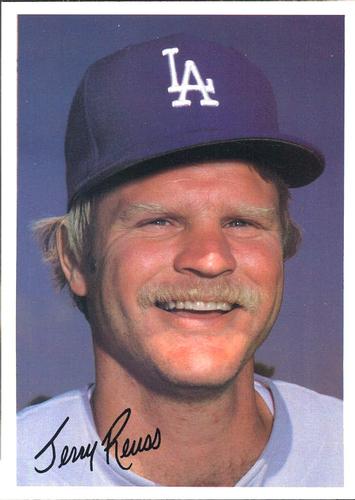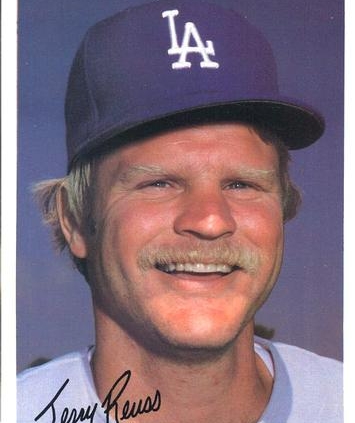August 10, 1981: Dodgers’ Reuss, Howe blank Reds in first game after strike ends
 After the 50-day players strike in 1981, in which about a third of the season was eliminated, major-league club owners elected to divide the season into two halves, each with its own division champions. The Los Angeles Dodgers ended the first half of the season with a record of 36-21, the best in baseball, a half-game ahead of the Cincinnati Reds in the National League West Division. Declared the division’s first-half champion and assured a playoff berth in a newly created best-of-five postseason round, they would take on the second-half division winner or if they finished first again, take on the team with the next-best record.
After the 50-day players strike in 1981, in which about a third of the season was eliminated, major-league club owners elected to divide the season into two halves, each with its own division champions. The Los Angeles Dodgers ended the first half of the season with a record of 36-21, the best in baseball, a half-game ahead of the Cincinnati Reds in the National League West Division. Declared the division’s first-half champion and assured a playoff berth in a newly created best-of-five postseason round, they would take on the second-half division winner or if they finished first again, take on the team with the next-best record.
Reds players and management expressed outrage at the decision to resume the season with a blank slate rather than building on the team’s first-half won-lost record.1 One could understand Cincinnati’s frustration. Just before the ballplayers walked out on June 11, the Reds had closed the gap in the standings between themselves and Los Angeles by winning their last seven games. The Dodgers, on the other hand, though catapulting out of the gate to start the season 14-5, due in no small part to the rookie sensation Fernando Valenzuela, by early June had lost their luster, dropping six of their eight games before the strike began.
The first game of the second half-season for the Dodgers and the visiting Reds was scheduled as a twilight game in Los Angeles to accommodate ABC’s Monday Baseball Game of the Week. Southpaw Jerry Reuss took the mound for the Dodgers, while right-hander Frank Pastore started for the Reds.
As the Dodgers ran out to their positions to start the game, they could hear a mix of boos and cheers. According to sportswriters’ accounts of the game, however, hometown fans remained largely passive after that. Los Angeles Times sports columnist Jim Murray commented on the fan tranquility in the first game back at Dodger Stadium: “The crowd had all the animation of a crowd watching a triple bypass. The New York Public Library is noisier.”2
Small wonder. All the game’s scoring would take place in the bottom of the second inning while many fans were still pushing their way through the turnstiles or standing in concession lines.
On an 0-and-2 count, Dodgers third baseman Ron Cey led off the Dodgers second by taking a Pastore fastball on the shoulder. Pedro Guerrero stepped up to the plate and lined a single past second baseman Ron Oester. The runners took second and third on an errant pickoff throw from Reds catcher Mike O’Berry. Cey scored the game’s first run when Mike Scioscia singled, Guerrero stopping at third. Shortstop Bill Russell, the dean of the Dodgers players, hit a sacrifice fly to score Guerrero. After Reuss grounded out, Davey Lopes singled, driving in Scioscia. Ken Landreaux followed with another single. Dusty Baker, who wound up hitting a team-leading .320 season average, sliced a pitch down the left-field line, scoring Lopes, but he found the ball waiting for him when he arrived at second for the inning’s final out. The Dodgers led 4-0, and the score would remain so for the rest of the game.
On their part, the Reds sputtered against Reuss, collecting just three singles: Dave Concepción in the first, Ray Knight in the second, and Ken Griffey in the sixth. Only one Red reached second base. Oester and Dave Collins, who walked in the second and third innings respectively, were each cut down trying to steal second by catcher Scioscia, then in his first full season with the Dodgers.
Despite the nearly two-month layoff, Reuss, who had completed six of his 11 starts in the first half, appeared to be in midseason form, except for his durability. Though he failed to go the distance, throwing 80 pitches in six innings, Reuss picked up a win to take his record to 6-2 and lower his ERA to 1.77. In the clubhouse after the game, Reuss said, “I was not going to go any further. I’m a little tired now.”3
Manager Tommy Lasorda brought Steve Howe out of the Dodgers bullpen to relieve Reuss. While training for the “second” season, Howe had been struck in the head by a line drive hit during batting practice, and had resumed throwing just two days earlier.
If the Reds were pleased to see Reuss exit the game, they soon discovered that the pitching change did not reverse their fortunes. In his three-inning stint, Howe, the left-handed relief specialist and 1980 Rookie of the Year, allowed only one Red to reach base, Oester, on a passed ball after striking out. Oester was erased on a double-play grounder hit by pinch-hitter Mike Vail. In earning his team-leading sixth save of the season, Howe later said he felt strong. “I could have gone five, six, or seven innings.”4
Reds starter Pastore was lifted for a pinch-hitter in the top of the third inning and took the loss to even his record at 3-3. He told reporters after the game, “If I get any breaks, I get out of the second inning with one run. The breaks didn’t go my way. … Nobody scorched the ball. I couldn’t believe I was out of there.”5
Reds manager John McNamara later acknowledged that Reuss, who finished second in the Cy Young Award voting behind Steve Carlton in 1980, looked to be on his game. McNamara knew his team could not afford to get down by any more runs to the Dodgers pitcher when he went to the bullpen early in the game. “He’s just a good pitcher. He’s tough any time,” the manager said.6 Still, McNamara felt his team made it a lot easier for Los Angeles by committing three errors (though they made only one in the four-run inning), and admitted, “We’ve played better. You don’t usually see some of the mistakes that we made tonight.”7
If there was a silver lining for the Reds, it was that the trio of relievers who followed Pastore into the game — Paul Moskau, Doug Bair, and Tom Hume — shut down the Dodgers. The Reds hurlers collectively allowed two singles and no runs in six innings of relief.
The game took a swift 2 hours and 8 minutes to play. Save for one game in May, the 35,120 in attendance at Dodger Stadium were the smallest crowd thus far in 1981, but on par with historical averages for twilight games. Inasmuch as the Los Angeles Rams were playing the New England Patriots in an NFL exhibition game down the freeway at Anaheim Stadium, the crowd size did not appear to have been especially affected by the recent baseball labor strife.
The Dodgers took two of three from the Reds in this set. (Over the full season each team won eight games.) The Reds concluded their 1981 season with the best overall record in the major leagues at 66-42, four games ahead of the Dodgers’ combined regular season record of 63-47. But that was not how success was measured in 1981. The Reds failed to make the postseason because they did not finish first in the NL West in either half-season. They finished 1½ games behind the Houston Astros in the second half, simply good for second place, again.
The Dodgers went on to defeat the Astros in five games in the Division Series, the Montreal Expos in five games in the NLCS, and the New York Yankees in six games in the World Series.
Sources
In addition to the sources cited in the Notes, the author consulted baseball-reference.com and retrosheet.org.
Notes
1 “I don’t care for the split season one iota,” Reds president Dick Wagner told the press. See Lonnie Wheeler, “Split-Season Plan Leaves Loose Ends,” Cincinnati Enquirer, August 1, 1981. Reds pitcher Bruce Berenyi expressed, “I don’t like it….I feel the Dodgers were in definite danger when the strike started and I don’t think they should benefit.” See Tim Sullivan, “Hitters Trail Pitchers, Fans as Reds Go to Work,” Cincinnati Enquirer, August 2, 1981; “The Reds are on record as despising the split-season format,” wrote Reds baseball beat writer Randy Holtz, Cincinnati Enquirer, August 10, 1981. A further sampling of the sentiment can be found in Mark Heisler, “Cincinnati Fumes Over Split Season,” Los Angeles Times, August 8, 1981; “Angry Reds Take on Dodgers in TV Game,” Newark (Ohio) Advocate, August 10, 1981, and “Reds’ McNamara Says Spilt Season `Stinks,’” Los Angeles Times, August 7, 1981.
2 Jim Murray, “Isn’t This Baseball Season a Little Long?” Los Angeles Times, August 11, 1981. For general accounts of the game see: Mark Heisler, “Reuss, Howe Squelch Boos and Reds, Too,” Los Angeles Times, August 11, 1981, and Tim Sullivan, “LA Pitchers Teach, Reds’ Bats Listless,” Cincinnati Enquirer, August 11, 1981.
3 “Dodgers Still No. 1 Dudes in the West Since the Strike,” Desert Sun (Palm Springs, California), August 11, 1981.
4 David Leon Moore, “Reuss, Howe Blank Reds on Three Hits,” San Bernardino County Sun (San Bernardino, California), August 11, 1981.
5 Hal McCoy, “Big Red Machine Has Timing Problem,” Dayton (Ohio) Daily News, August 11, 1981.
6 “Dodgers Still No. 1 Dudes in the West Since the Strike.”
7 “Dodgers Still No. 1 Dudes in the West Since the Strike.”
Additional Stats
Los Angeles Dodgers 4
Cincinnati Reds 0
Dodger Stadium
Los Angeles, CA
Box Score + PBP:
Corrections? Additions?
If you can help us improve this game story, contact us.


